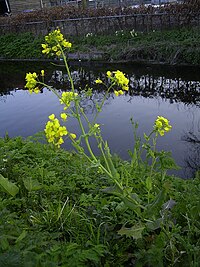
Photo from wikipedia
Strain ATSA2T was isolated from surface-sterilized kimchi cabbage (Brassica rapa subsp. pekinensis) seeds and represents a novel bacterium based on the polyphasic taxonomic approach. A phylogenetic analysis based on 16S… Click to show full abstract
Strain ATSA2T was isolated from surface-sterilized kimchi cabbage (Brassica rapa subsp. pekinensis) seeds and represents a novel bacterium based on the polyphasic taxonomic approach. A phylogenetic analysis based on 16S rRNA gene sequences showed that strain ATSA2T formed a lineage within genus Saccharibacillus and was most closely to Saccharibacillus deserti WLG055T (98.1%) and Saccharibacillus qing-shengii H6T (97.9%). The whole-genome of ATSA2T comprised a 5,619,468 bp of circular chromosome with 58.4% G + C content. The DNA-DNA relatedness values between strain ATSA2T and its closely related type strains S. deserti WLJ055 and S. qingshengii H6T were 26.0% and 24.0%, respectively. Multiple gene clusters associated with plant growth promotion activities (stress response, nitrogen and phosphorus metabolism, and auxin biosynthesis) were annotated in the genome. Strain ATSA2T was Gram-positive, endospore-forming, facultatively anaerobic, and rod-shaped It grew at 15–37°C (optimum 25°C), pH 6.0–10.0 (optimum pH 8.0), and in the presence of 0–5% (w/v) NaCl (optimum 1%). The major cellular fatty acids (> 10%) of strain ATSA2T were anteiso-C15:0 and C16:0. MK-7 was the major isoprenoid quinone. The major polar lipids present were diphosphatidylglycerol, phosphatidylglycerol, and three unknown glycolipids. Based on its phylogenetic, genomic, phenotypic, and chemotaxo-nomic features, strain ATSA2T is proposed to represent a novel species of genus Saccharibacillus, for which the name is Saccharibacillus brassicae sp. nov. The type strain is ATSA2T (KCTC 43072T = CCTCC AB 2019223T).
Journal Title: Journal of Microbiology
Year Published: 2019
Link to full text (if available)
Share on Social Media: Sign Up to like & get
recommendations!